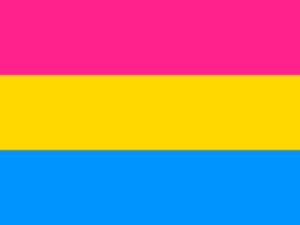
A Brief History and Appreciation of Pansexuality (and Symbols)
The term pansexual, or rather, pansexualism, first appeared in 1914 in the days of Sigmund Freud. Contrary to popular opinion, the term was coined by one of Freud’s scholarly critics, J. Victory Haderman, in the Journal of Abnormal Psychology. In its early days, pansexualism did not refer to one’s sexual orientation. Rather, it was a psychoanalytic term that represented the idea that “sex motivates all things.”
Pansexuality falls under the bisexual umbrella, though they are not the same thing. In brief, bisexuals can be attracted emotionally or physically to more than one gender and gender plays some role in that attraction. Pansexuals can be attracted to others of any gender because gender does not impact their attraction to another person. Pansexuals can also be said to be “gender blind.” The distinction and similarity between these two sexual orientations are discussed in more detail in our previous blog here.
To celebrate National Pansexual Pride Day, we want to go over some common and identifying symbols within the pansexual community.
 The Pansexual Symbol (it does not have an official name) effectively combines a cross and an arrow design in the shape of a P.
The Pansexual Symbol (it does not have an official name) effectively combines a cross and an arrow design in the shape of a P.
A cross is traditionally associated with Venus and women, and an arrow is a symbol for Mars and men. Combining an arrow and a cross is a symbol for the transgender community. The design highlights that pansexuality is not limited to gender or sexual orientation—love and attraction can span nonbinary orientations and identities. The pansexual symbol served as an early symbol of the community before the pansexual flag and is still used today.

The pansexual flag first appeared on the internet in 2010. It was designed by a Tumblr user known as Jasper V. The tri-striped flag uses three colors: pink, blue, and yellow. Pink represents those who identify as female, blue represents those that identify as male, and yellow represents those who identify anywhere on the gender spectrum. Like the pansexual symbol, these colors represent the different identities and orientations that pansexuals may be attracted to. The flag was originally created to highlight pan visibility and to separate the pansexual community from the bisexual community.
In the late 2010s, when notable celebrities like Miley Cryus and Janelle Monáe came out as pansexual, the term finally emerged into the mainstream public consciousness. Usage of the flag also gained traction and pansexual flags became one of the flags commonly seen flying around alongside the Rainbow Pride flag today.
December 8 marks National Pansexual Pride Day. Pansexuality pushes our conception of what sexual orientation and attraction can be. By celebrating pansexuality, we can better understand how to be inclusive of others and their differences from societal norms. At the end of the day, pansexuality is valid and should be supported, after all, all love is love
Happy Pansexual Pride Day from Project More!
If you’re interested in other symbols in the LGBTQ+ community, follow our blog featuring these and other LGBTQ+ topics, news, and history!

